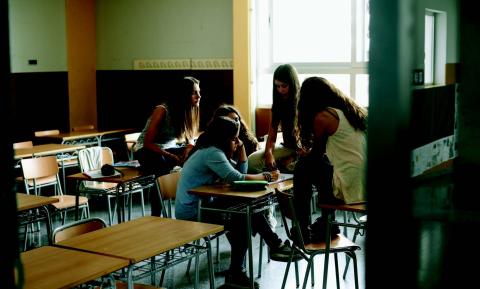Teaching Teens with Autism to Talk to Peers

When Lehigh professors Linda M. Bambara and Christine L. Cole first met a boy who would become part of their research helping teens with autism interact with peers, he was sitting alone in a stairwell during lunch period at Allen High School in Allentown, Pa.
Bambara, Cole and a team of doctoral students worked before and after lunch periods with the teen, who has high-functioning autism, and by the end of the school year, he was conversing happily with other students who called him their friend.
The difference was startling.
“Cafeteria workers, teachers all say, ‘Wow, what have you done?'” said Bambara. “Really the only thing we’ve done is teach the students with autism relatively simple strategies for engaging in conversation with their peers and providing supports to them like meeting with them and encouraging them.”
Bambara, professor of Special Education, and Cole, professor of School Psychology, have been working with autistic students at Allen since 2012 and have written about the results of their research in several professional journals, including Research in Autism Spectrum Disorders and SIG Perspectives, a journal of the American Speech-Hearing-Language Association. In previous years, the project trained typical teens in how to engage students who had both intellectual disabilities and autism in conversation, while also teaching those with autism how to ask questions and make appropriate comments.
This past school year, the researchers worked with three students who had high-functioning autism and were in general education classes. They focused more on working with the teens on how to initiate and carry on conversations, while showing interest in their conversational partners.
“One of the deficits that kids with autism may have is they talk a lot about themselves and their own interests,” Cole said. “So we taught them to listen to what their friends were saying and show interest by asking questions about what they just said or making a comment like ‘Wow, that sounds like fun.’”
Initially, the researchers had the students practice role-playing with sample conversations and write down questions they might ask. But by the end of the school year, the students were talking with peers unrehearsed.
The researchers obtained audio recordings of each lunchtime session which documented the students’ dramatic progress. Parents told them their child is also talking more at home.
The stakes are high for teens with autism.
“If you don’t make a change in the school-age population, these problems are going to continue into the future,” Cole said. “Mental health issues can occur—anxiety, depression, certainly social isolation.”
The students with autism have been very positive about their own progress. The accepted stereotype is that people with autism prefer to be alone and don’t like interacting with others. Bambara said their research shows otherwise.
“Given the opportunity, the skills and the support, they want to be able to have social interactions with their peers,” she said.
A prominent autism researcher, Debra Kamps of University of Kansas, has done similar intervention work with young children but was skeptical it could work with teens, Bambara said. “But then she came to our sessions and now she’s a big fan, and she said she wants to begin to replicate our work,” Bambara said. “That’s how you begin to have an impact where other people see what’s possible.”
And the boy in the stairwell?
“Now he has friends, other friends that we didn’t involve in our project,” Cole said.